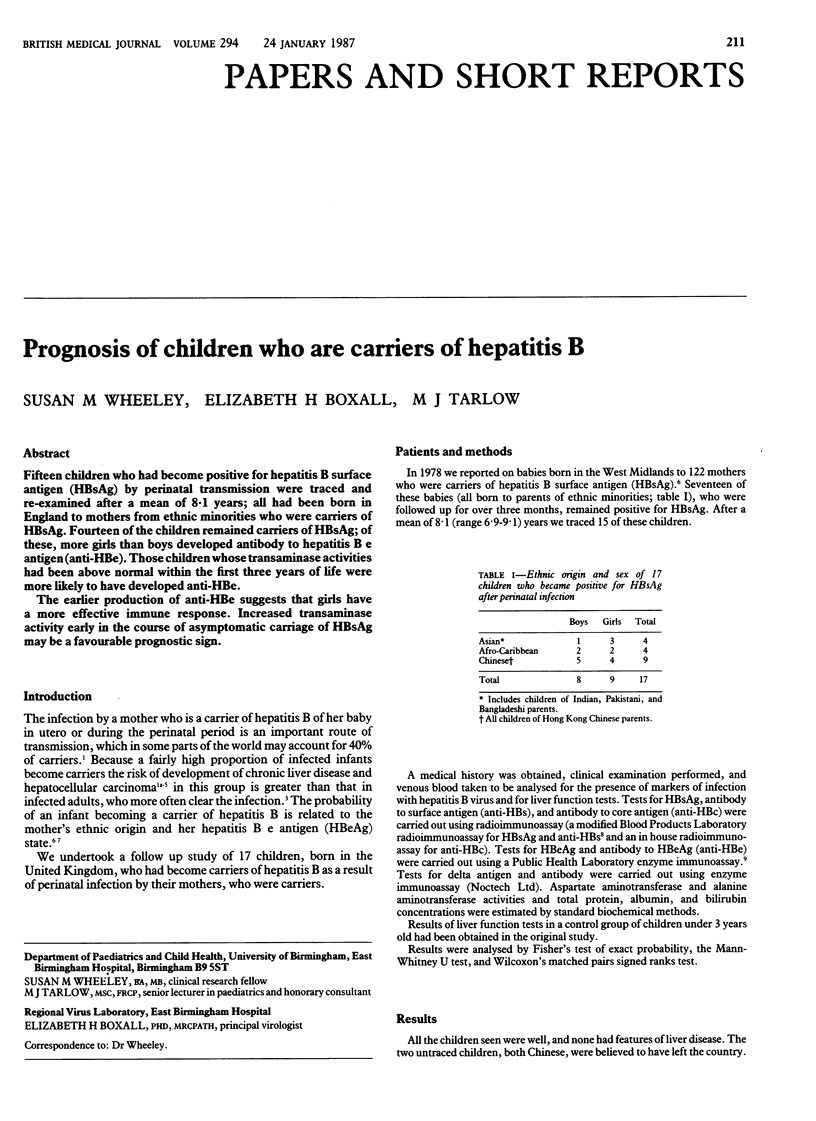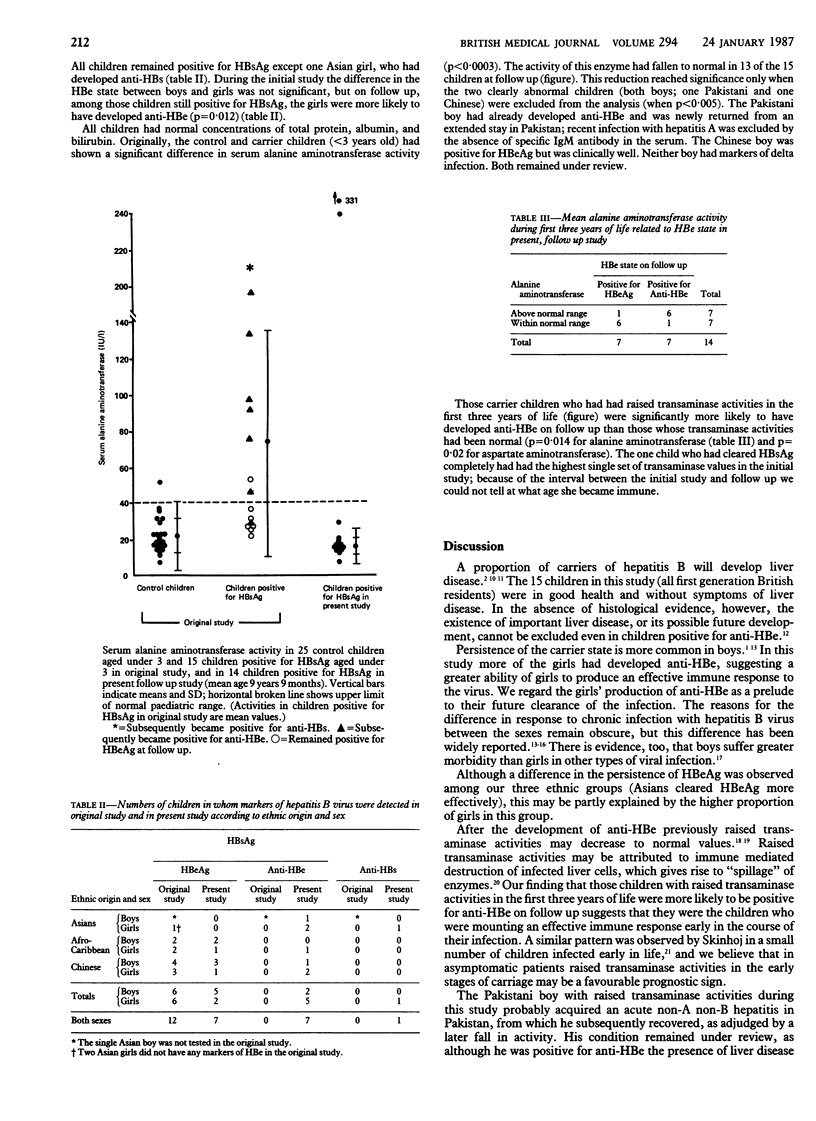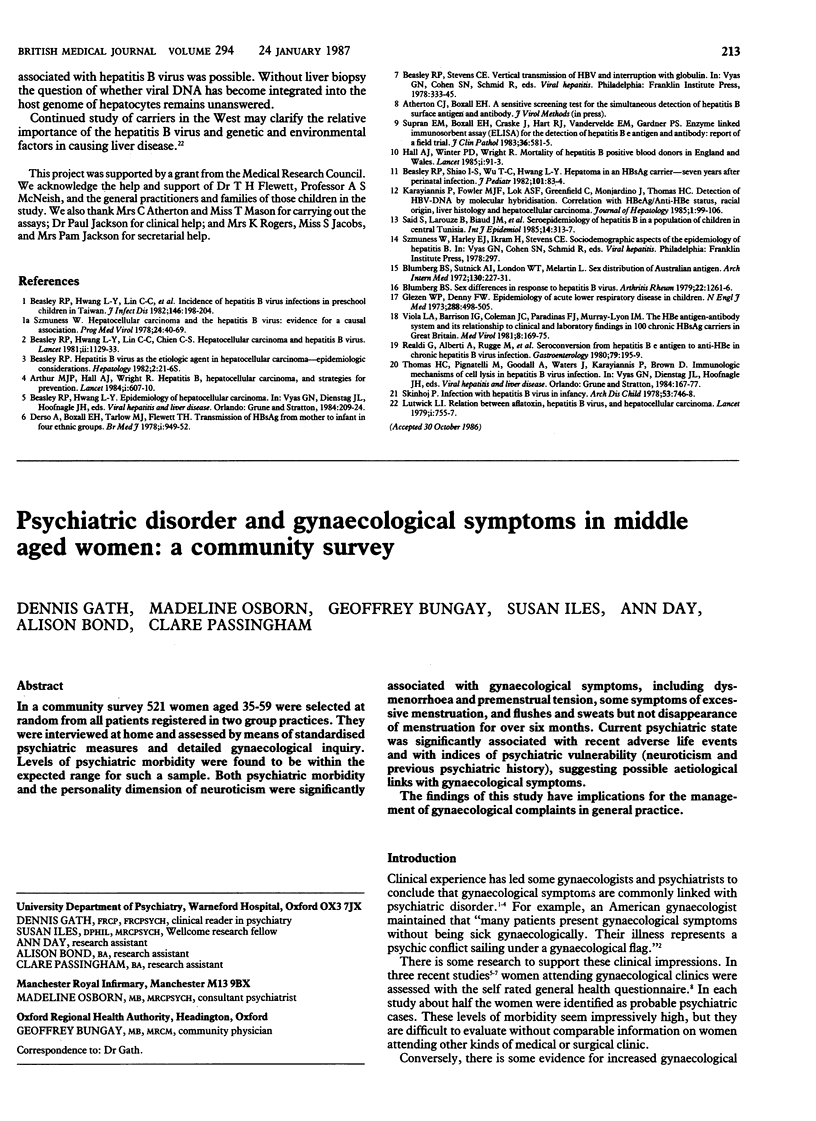Abstract
Fifteen children who had become positive for hepatitis B surface antigen (HBsAg) by perinatal transmission were traced and re-examined after a mean of 8.1 years; all had been born in England to mothers from ethnic minorities who were carriers of HBsAg. Fourteen of the children remained carriers of HBsAg; of these, more girls than boys developed antibody to hepatitis B e antigen (anti-HBe). Those children whose transaminase activities had been above normal within the first three years of life were more likely to have developed anti-HBe. The earlier production of anti-HBe suggests that girls have a more effective immune response. Increased transaminase activity early in the course of asymptomatic carriage of HBsAg may be a favourable prognostic sign.
Full text
PDF


Selected References
These references are in PubMed. This may not be the complete list of references from this article.
- Arthur M. J., Hall A. J., Wright R. Hepatitis B, hepatocellular carcinoma, and strategies for prevention. Lancet. 1984 Mar 17;1(8377):607–610. doi: 10.1016/s0140-6736(84)91006-7. [DOI] [PubMed] [Google Scholar]
- Beasley R. P., Hwang L. Y., Lin C. C., Leu M. L., Stevens C. E., Szmuness W., Chen K. P. Incidence of hepatitis B virus infections in preschool children in Taiwan. J Infect Dis. 1982 Aug;146(2):198–204. doi: 10.1093/infdis/146.2.198. [DOI] [PubMed] [Google Scholar]
- Beasley R. P., Shiao I. S., Wu T. C., Hwang L. Y. Hepatoma in an HBsAg carrier--seven years after perinatal infection. J Pediatr. 1982 Jul;101(1):83–84. doi: 10.1016/s0022-3476(82)80190-x. [DOI] [PubMed] [Google Scholar]
- Blumberg B. S. Sex differences in response to hepatitis B virus. I. History. Arthritis Rheum. 1979 Nov;22(11):1261–1266. doi: 10.1002/art.1780221114. [DOI] [PubMed] [Google Scholar]
- Blumberg B. S., Sutnick A. I., London W. T., Melartin L. Sex distribution of Australia antigen. Arch Intern Med. 1972 Aug;130(2):227–231. [PubMed] [Google Scholar]
- Derso A., Boxall E. H., Tarlow M. J., Flewett T. H. Transmission of HBsAg from mother to infant in four ethnic groups. Br Med J. 1978 Apr 15;1(6118):949–952. doi: 10.1136/bmj.1.6118.949. [DOI] [PMC free article] [PubMed] [Google Scholar]
- Glezen P., Denny F. W. Epidemiology of acute lower respiratory disease in children. N Engl J Med. 1973 Mar 8;288(10):498–505. doi: 10.1056/NEJM197303082881005. [DOI] [PubMed] [Google Scholar]
- Hall A. J., Winter P. D., Wright R. Mortality of hepatitis B positive blood donors in England and Wales. Lancet. 1985 Jan 12;1(8420):91–93. doi: 10.1016/s0140-6736(85)91976-2. [DOI] [PubMed] [Google Scholar]
- Karayiannis P., Fowler M. J., Lok A. S., Greenfield C., Monjardino J., Thomas H. C. Detection of serum HBV-DNA by molecular hybridisation. Correlation with HBeAg/anti-HBe status, racial origin, liver histology and hepatocellular carcinoma. J Hepatol. 1985;1(2):99–106. doi: 10.1016/s0168-8278(85)80759-5. [DOI] [PubMed] [Google Scholar]
- Lutwick L. I. Relation between aflatoxin, hepatitis-B virus, and hepatocellular carcinoma. Lancet. 1979 Apr 7;1(8119):755–757. doi: 10.1016/s0140-6736(79)91210-8. [DOI] [PubMed] [Google Scholar]
- Realdi G., Alberti A., Rugge M., Bortolotti F., Rigoli A. M., Tremolada F., Ruol A. Seroconversion from hepatitis B e antigen to anti-HBe in chronic hepatitis B virus infection. Gastroenterology. 1980 Aug;79(2):195–199. [PubMed] [Google Scholar]
- Said S., Larouze B., Biaud J. M., Sabbagh K., Yang C., Gaumer B., Jemmali M., Gaudebout C. Seroepidemiology of hepatitis B in a population of children in central Tunisia. Int J Epidemiol. 1985 Jun;14(2):313–317. doi: 10.1093/ije/14.2.313. [DOI] [PubMed] [Google Scholar]
- Skinhøj P. Infection with hepatitis B virus in infancy. A longitudinal study of 8 cases. Arch Dis Child. 1978 Sep;53(9):746–748. doi: 10.1136/adc.53.9.746. [DOI] [PMC free article] [PubMed] [Google Scholar]
- Supran E. M., Boxall E. H., Craske J., Hart R. J., Vandervelde E. M., Gardner P. S. Enzyme-linked immunosorbent assay (ELISA) for the detection of hepatitis Be antigen and antibody: report of a field trial. J Clin Pathol. 1983 May;36(5):581–585. doi: 10.1136/jcp.36.5.581. [DOI] [PMC free article] [PubMed] [Google Scholar]
- Szmuness W. Hepatocellular carcinoma and the hepatitis B virus: evidence for a causal association. Prog Med Virol. 1978;24:40–69. [PubMed] [Google Scholar]
- Viola L. A., Barrison I. G., Coleman J. C., Paradinas F. J., Murray-Lyon I. M. The HBe antigen-antibody system and its relationship to clinical and laboratory findings in 100 chronic HBsAg carriers in Great Britain. J Med Virol. 1981;8(3):169–175. doi: 10.1002/jmv.1890080303. [DOI] [PubMed] [Google Scholar]


